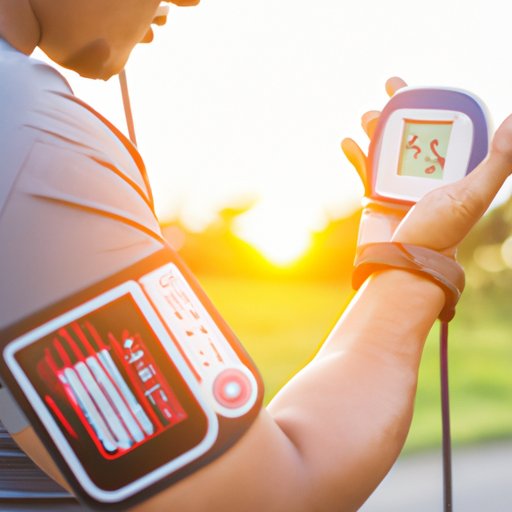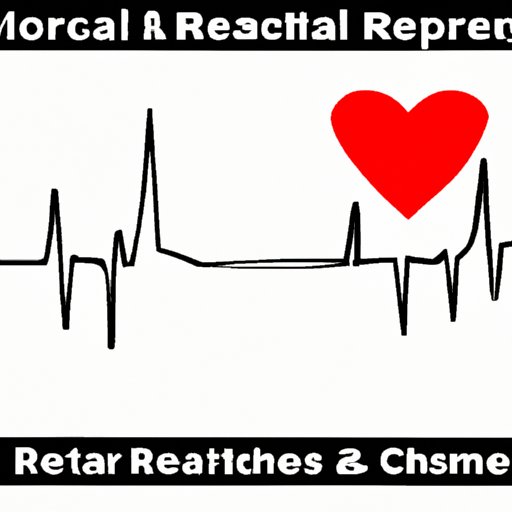
Introduction
Heart rate (HR) increase during exercise refers to the phenomenon of a faster heartbeat when the body is active. The body’s HR increases to deliver more oxygenated blood to the muscles, enabling them to work harder. Understanding this physiological process is crucial because it affects our overall health, fitness, and athletic performance.
The Science Behind HR Increase During Exercise: Exploring the Physiology
The heart plays a fundamental role in our bodies, continuously pumping blood throughout the circulatory system. It delivers oxygen and nutrients to the body’s organs and tissues while removing waste products. During exercise, the heart pumps faster to supply the muscles with enough oxygen and nutrients. The increased rate at which it pumps blood results in an elevated HR.
When we engage in physical activity, the body requires more oxygen to produce the energy required by the muscles. The lungs consume more oxygen to meet this demand, and the heart starts to pump faster to transport oxygen and nutrients to the muscles. During exercise, the cardiovascular system works together with the respiratory system, supplying the body with enough oxygen to maintain aerobic metabolism. As a result, our HR increases during exercise as the heart works harder to deliver enough oxygenated blood to the muscles.
Why Your Heart Beats Faster When You Work Out: Understanding HR Increase
An individual’s resting HR, which can be measured when the body is at rest, varies depending on several factors such as age and fitness level. On average, normal resting HR ranges from 60 to 100 beats per minute (bpm). During exercise, the HR increases, and the intensity and duration of the activity determine just how much.
The factors that influence HR increase during exercise include age, fitness level, exercise modality, intensity, duration, and environmental conditions. For example, an individual’s HR may rise more swiftly, and by a larger amount, during high-intensity activities such as sprinting, compared to low-intensity activities such as walking.
There are benefits to an elevated HR during exercise, however. The heart is a muscle that strengthens with exercise, so moderate HR increases triggered by physical activity can help maximize heart function. Exercise can help reduce the risk of heart disease and other chronic health conditions and help individuals achieve an overall better quality of life.

Breaking Down the Relationship Between Exercise and Heart Rate Changes
Measuring HR during exercise is easy, and it can help an individual monitor their overall fitness and athletic performance. One way is through monitoring your pulse, and another is through heart rate monitors, which can provide instantaneous and accurate information.
Increasing exercise intensity, regardless of the type of exercise, leads to an increase in heart rate. Higher intensity activities will result in an increase in HR than moderate-intensity activities. As workouts become more challenging, the body starts to rely on anaerobic metabolism, which relies on glucose rather than oxygen, and the body may shift into an oxygen debt. In response, our HR will increase to deliver more oxygen and meet the demand.
Unpacking the Link Between Physical Activity and Elevated Heart Rate
The correlation between overall fitness and resting HR is well established — the fitter an individual, the lower their resting HR will be. Regular exercise is essential for cardiovascular health and lowering one’s resting HR. Engaging in exercise can decrease blood pressure and reduce the risk of other health conditions such as heart disease.
Long-term benefits of regular exercise on heart function are well documented. Engaging in regular physical activity can lower an individual’s risk of developing cardiac health conditions, including heart disease, by strengthening the heart and the circulatory system. The American Heart Association recommends that adults engage in at least 150 minutes of moderate-intensity aerobic activity or 75 minutes of high-intensity aerobic activity per week.
HR Increase During Exercise: What You Need to Know for Your Workouts
Before engaging in any physical activity, it is essential to warm up. A warm-up prepares the body for the upcoming activity, and it can significantly reduce an individual’s risk of injury. A typical warm-up should include activities that gradually increase the body’s temperature and heart rate, such as light cardio and stretching.
The intensity of physical activity during workouts should be monitored based on an individual’s fitness level. To maximize the cardiovascular benefits of exercise, it is essential to achieve a target heart rate zone based on an individual’s age and fitness level. There are different heart rate zones, including the warm-up, moderate-intensity, and high-intensity zones. Engage in muscle-strengthening activities two days a week in combination with aerobic activity for the best results.
To better track heart rate during exercise, using a heart rate monitor is a reliable option. It allows an individual to gauge their exercise intensity to ensure they are staying within the recommended heart rate zone for the activity they are performing.
Maximizing Your Workouts with an Understanding of HR Increase
The benefits of exercise should not come at the expense of overexertion or the risk of injury. One should develop an exercise plan that is challenging and sustainable based on their fitness level and goals. It is crucial to listen to your body and be sure to incorporate enough rest and recovery time to avoid injury. Recovery can take the form of rest days, massages, and proper hydration and nutrition.
The right type of exercise is also important. It is essential to tailor exercises to specific fitness goals. For example, weightlifting can help build strength, while endurance activities such as running or cycling can boost cardiovascular fitness.
Conclusion
Heart rate increase during exercise is a crucial element to understand in optimizing one’s workouts. Knowing how one’s HR responds to different exercise conditions, as well as the factors that determine those responses, is critical to improve overall fitness. We hope this article will help readers understand the science behind HR increase during exercise and how to monitor HR to maximize the benefits of regular physical activity.
Additional Resources
For more information on heart rate and exercise, see these resources.
- National Heart, Lung, and Blood Institute. Physical Activity and Your Heart.
- American Heart Association. Target Heart Rates.
- The National Academy of Sports Medicine. Personal Trainer Certifications.





